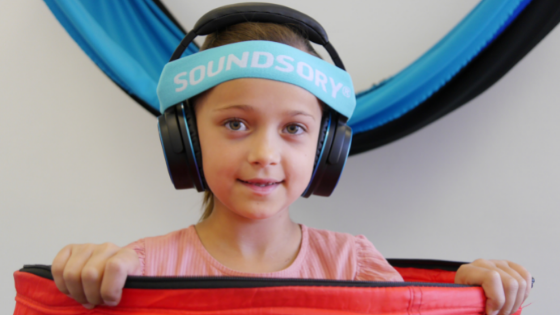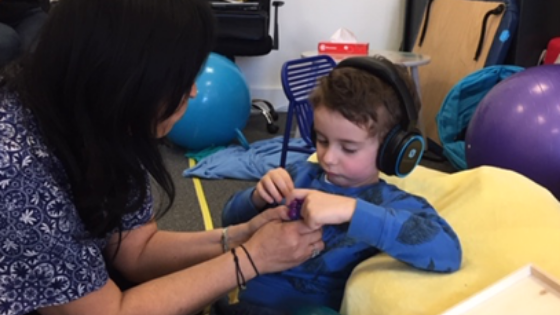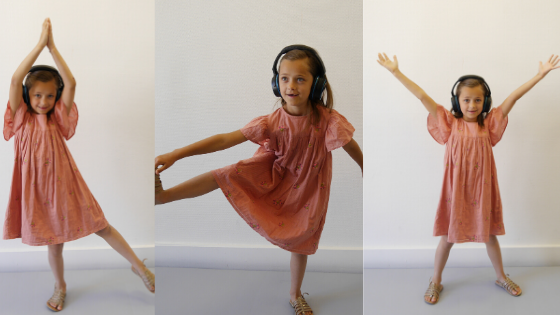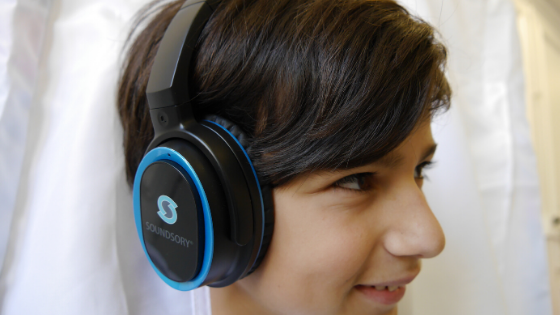
By Kara Tavollaci, OT
As an Occupational Therapist who has worked with, continues to work with, and loves working with children on the Autism spectrum, I have used many tools to achieve the goals that I have for each individual child that I see. My favorite tools to use are auditory tools, and specifically Soundsory. I am going to start with an example of a young 5 year old boy who is diagnosed on the Autism spectrum and completed a full Soundsory program.
I will describe this young little boy focusing on 3 areas – his motor profile, level of engagement, and his language and communication skills.
Motor Skills – The boy, Camille, who preferred to be on the ground, was fearful of movement, had poor posture, would constantly lean on you or anything in his environment, and would “W” sit. He was kind of like a wet noodle! He struggled with coordination games that required imitation. Most motor tasks would be attempted once maybe twice then he would retreat into his own world. He definitely had poor endurance to physical activities.

Engagement Level – His level of engagement often involved me doing cartwheels to try and get interaction and sustain interaction with him. He was very happy to be doing his own thing on his own terms. There was no initiation of engagement, I always brought the interaction to him and even then it was once or twice and then he would retreat.
Language and Communication – Camille had language but always required multiple prompts and cues to get him to repeat and use his words. He struggled to sustain his attention to the interaction in front of him. He could follow simple verbal directions and routines. His receptive language skills were much stronger than his expressive language.
So what did I recommend for Camille based on his profile? Soundsory!
After about 2 weeks of listening at home he was coming into our sessions and climbing up and staying with motor activities for 6, 7 even 8 times compared to his previous 1 or 2 times if I was lucky. There was less fear observed during motor tasks. He seem to be more playful. After another two weeks these skills continued and he was always coming in participating for much longer periods of time, he even initiated a game with me which he had never done before! His motor system was changing, he was feeling more confident and more tuned in. After another 2 weeks he was repeating words sometimes spontaneously and sometimes with just a gestural cue. His ability to repeat was much quicker. When highly motivated he was spontaneously using words during our interactions. The growth and development was really awesome to see in just a month! There was much more of a give and take now in our interactions. It wasn’t always me initiating the interaction.
Read an in-depth account of how I worked with Camille, here!
Hopefully this has sparked your interest to read on a bit further and see what this program is all about. As a parent of a child who is on the Autism spectrum or has been recently diagnosed on the Autism spectrum, I imagine there are many things you have googled, looked up, tried, or heard about to help your child grow and develop. You may have used tools for communication, tools to help with schedules and routines and possibly adaptive tools to help your child complete written tasks. Your tool box is full of great tips, strategies, advice, and exercises that you use to support the growth and development of your child who is on the Autism spectrum.

What we want to do today is tell you about a great tool that I mentioned before that can easily fit into your tool box. It is a music and movement program called Soundsory. When you think about your child whether they are on the Autism spectrum or not, what they are always using on a daily basis is their auditory systems (hearing and listening) and their vestibular systems (motor skills, balance,body schema). If you think back to the little boy I just talked about that may help you visualize things that may be of concern and things that may be helped by the Soundsory program.
We know that recently the world has become a very different place at the moment and you may now have taken on the role of not only parent but teacher and therapist. Your child may be spending more time in front of a computer for school and less time moving. We will try and be as brief as possible while giving you tons of information on how Soundsory can work for you and your child.
RHYTHMIC MUSIC LISTENING
Soundsory in a nutshell is a super easy to use program. It consists of less than 30 minutes of listening for 30-40 days. What you have to do is turn the headset on, choose your day, put the headset on your child and set a timer. That’s it! Of course you also have to periodically charge the headsets as you would any other electronic device. If you have other family members that wanted to use the headphones they could pair it to any bluetooth device to listen to their own music for example. The program is inexpensive and can be repeated multiple times. Now that you have the general idea of the program lets get into more specifics and details about the program itself.
THE BODY MOVEMENT EXERCISES
This program comes with a variety of developmental exercises that you can follow along to on line. These exercises do not use any other tool, object, or extra piece of equipment. Just your body! They cover a variety of different areas from reflex integration to gross motor and fine motor exercises. These exercises are not required however since this is a music and movement program we do encourage you to move while you are listening. It can be as simple as taking a walk in your house and moving from room to room.
Dance along to the music as each song changes and the rhythm changes between each song. Many children that I work with as an Occupational therapist on the Autism Spectrum often have difficulties with coordination and motor tasks. If you have a therapy team and they have provided you with any movement exercises feel free to incorporate them into your listening sessions. Since many of you parents have taken on the role of teacher during these new times and your child is spending more time in front of the computer screen you can use the headsets as part of your movement breaks.
It can give a really nice boost to their bodies that can help them be more attentive, focused and read for their next lesson. Be creative! Your options are limitless!
THE VESTIBULAR SYSTEM
Before we get into “the what” and more technical aspects of the program we are going to talk a little bit about this big system that is integral to the human body called the vestibular system. This system is constantly being used all day long. It is the foundation for the development of the rest of your sensory systems such as touch, vision, sound and proprioception. It is through this system that we develop our sense of balance, coordination, motor control of the eye, ability to use both sides of the body, our posture, our sense of movement, knowing where we are in space. This system is located in our ears and is closely linked to the auditory system. When it is working as it should we really don’t give it much attention. When it is not working as it should we may see that our kids are a little clumsier, or struggle with coordination tasks or sitting up in school.
Let’s continue those ideas. Think about the current activities that your child is required to participate in. If he is in school, speech therapy or ABA therapy he may be required to sit up in a chair to complete his work, or sit during circle time (posture). They may be required to participate in gym class and engage in coordinated movements and skills, such as ball games and sports. In art class they may be required to use both hands together, one to stabilize their paper while the other is writing or cutting. They may use a communication device and be required to hold their tablet with one hand while pushing a button with the other. The list of motor skills your child is required to do throughout his day is numerous. When this motor system is working smoothly your child has an easy time completing these tasks. But when it is not working smoothly, these tasks require much more effort and can lead to avoidance or meltdowns.
This is where Soundsory comes in. This program is a way to enhance and improve the functioning of the vestibular system that will help your child be more available and better able to use the tools, tips and strategies that his therapist has provided for him. As an occupational therapist this is often a tool that I recommend to families to really help those foundational motor skills that are used throughout the child’s day. It is a way to provide support and a boost to their motor system to make it function more fluently to be able to develop the skills necessary to sit up during table work, participate in gym classes, and navigate school or new environments. I am sure you as parents could name many other daily routine motor tasks that can be difficult for your child.
HOW DOES SOUNDSORY WORK?
We talked about the importance of the body on everything we do and why we recommend this program. Now we are going to talk about the technical aspects of the program and how it works. The program consists of 40 days of music. What you see on the headset menu is day 1.1, day 1.2 all the way up to day 40.1, 40.2. Each day with a .1 after it has 9 different pieces of music. Each day with a .2 after it has just one track of music that is designed to be paired with the exercise portion of the program. However as an occupational therapist that works with kids and uses the program you will see that your kids will want to move right away!
The music consists of jazz, latin, gospel, marches and children songs. In addition there are some classical pieces Strauss, Hayden, and Bach. Each piece is between 2 to 3 minutes long depending on the track. The music was specifically designed to have more emphasis on rhythms. Rhythm is closely linked to the vestibular system and the body. Think about when your child was just a baby. If they got upset or were crying what did you most likely do? Rock them rhythmically back and forth. When we talk about Sensory diets with children or regulating activities with children a big part of those activities involve rhythmic activities. Rhythm is also used to get individuals moving, think about when you listened to salsa music or marches, your body wants to get up and move.

All these pieces of music we mentioned above are loaded onto the headsets and are delivered through both bone conduction and air conduction. Bone conduction is sounds transmitted through your bones, through your body. Think about the last time you went to a rock concert, you could feel the music vibrating through your body. We use this type of sound transmission because it is the fastest way to get to the vestibule part of the ear and all that relates to motor skills.
The next thing that makes Soundsory a unique program is that the headsets consists of a dynamic filter which is a gating system along with delays. What does this gating system mean and why is it important? The gating system is a way of saying perceptual contrast. So there is this perceptual contrast within each piece of music. What happens is when you listen to a piece of music you will hear different points in the music where the music becomes brighter, more intense at times and at other moments the music will sound less bright and fainter. When the music is in the brighter phase it means both more higher frequency sounding parts and more energy. This is very important because we want to surprise the brain and keep it in a state of interest so that we don’t tune out the music. Think about the last time you were in a meeting and heard the continuous same sound vibration of the heating or air conditioning system, eventually your brain and auditory system would learn to tune out this sound so that you could focus on your meeting. It would become uninteresting and not important so your attention would not be directed towards it. This sound contrast is in all pieces of music on the Soundsory program. It provides a way to exercise the two tiny muscles that are in your middle ear. We want to make these two muscles in the ear work more effectively and as a consequence improve better regulation of the vestibule and all the consequences of that; improved body awareness, posture, coordination etc. Children on the Autism spectrum can often struggle with using their ears. They may be more sound sensitive or tune out the world in general, and they may have difficulties with motor skills as we mentioned earlier.
We mentioned delays that go along with the gating system but what does that mean? These delays allow for a time of preparation. They give the brain time to process the incoming information of the music that is conveyed by the gating system. It can be thought of as a warning system in a sense, get ready, get the body ready, here comes the sound. This ability to anticipate, adapt and process incoming information is often difficult for individuals on the Autism spectrum.
All these parameters are what make Soundsory a very unique program and very different from just listening to music on a nice pair of headphones. These parameters really help target the motor system, work the auditory system and help individuals with Autism develop these skills as they continue to learn and grow.
We hope that this introduction to Soundsory helps you have a better understanding of the program and how it can be beneficial for your child. We realize your time is precious and even more so these days as you take on new roles to continue your child’s education.
CHECKLIST OF SYMPTOMS
Here is a quick checklist to help you decide whether or not this program can be beneficial for your child on the Autism spectrum –
- Does your child have low muscle tone, tend to W sit, seem floppier than others?
- Does your child struggle with sitting up against gravity? Do they prefer to lie down and watch things move or spin?
- Does your child engage once in a motor task and then tend to give up?
- Does your child seem to have poor endurance?
- Does your child have difficulty with gross motor skills, jumping, skipping, hopping
- Does your child have trouble with fine motor skills: writing, coloring, tracing, cutting
- Does your child have some words but it takes doing cartwheels and standing on your head to get them to use these words?
- Are they a little tuned out to what is happening in their auditory environment around them?
- Do they struggle to stay engaged with activities?
- Do they have difficulties initiating activities?
Our list can go on and on and on. They key things that you want to think of when deciding to choose this Soundsory program are, 1. Does my child have any difficulties in motor skills? and 2. Does my child have any difficulty with listening, communicating and using their auditory systems? If your child works with an occupational therapist they can help you identify some of these areas.
Again, this is just an introduction to help you get an idea of what Soundsory is all about. The key thing to remember is just how important our auditory and movement system are in our daily life activities. Soundsory is a way to help improve these systems so that your child can continue to grow, develop and become as independent as they can be. Our team are always available to you to answer any questions you may have as well as provide technical support if needed. We look forward to hearing from you as you start your Soundsory journey!
Thank you for reading!

